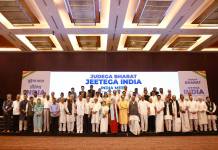By Aparna Menon
The one and only Bamboo Museum of India is housed in Palampur, Himachal Pradesh; on the premises of the Institute of Himalayan Bio-resource Technology which is one of the many research laboratories of the Council of Scientific and Industrial Research of India. The museum is built with various species of this ‘woody grass’, giving one an insight into the varieties that can be found and the various uses that they can be put to. Numerous handicrafts made out of bamboo and bamboo seeds have been placed on display within the museum. Outside the museum different varieties of bamboo have been planted in pots for visitors to see. The Institute uses the museum to provide information about their various projects and to educate the visitors about the good work that the scientists there are doing.
There are about 125 varieties of this perennial evergreen plant found in India and around 50 of them are grown in the Institute. Bamboo comes in various colours, sizes and girth. It is stronger than steel, it is earthquake proof and an extremely effective erosion control agent. “What most of us do not know is that Thomas Alva Edison used a carbonized bamboo filament in one of the first electric bulbs that he invented. Also, bamboo was the only plant that survived the nuclear radiation caused by the atomic blast in Hiroshima in 1945,” says Dr Anil Sood, who recently retired as the Director of IHBT. Bamboo or
Bamboo or Bambuseae, is a tribe of flowering perennial evergreen plants and one of the most versatile grasses found on Earth. This amazing grass which grows in clumps can be grown anywhere. It is extremely fast growing and can be harvested and put to use very soon. Bamboo grows naturally in the North – Eastern and the Southern parts of India, where the geographical conditions have always been suitable for it to grow. For centuries now, people have been using bamboo for almost everything from food to construction. This is one of those grasses which will alleviate the problem of food, clothing and housing (roti, kapda aur makaan) in the entire country. Bamboo can be used as a wood substitute for construction work and also for making furniture. As activated charcoal it can be used in water filtration plants and in vineries. We can make paper, cloth, handicraft items, weapons and musical instruments from bamboo. While the shoots and other tender parts of the plant are used to make pickles and other food items.
Bamboo is the best solution for all our land and soil related problems. All we have to do is plant bamboo on all the barren pieces of land and this will create afforestation and reduce soil erosion. There is a variety of bamboo which is thorny and sturdy, if this is planted along our international borders, we can easily create a natural fencing. Dr Anil Sood, who has done research on this grass for many years now, says, “bamboo is the only hope for the Indian rural masses”. ‘The Green Gold of the Forest’ has taught him to ‘be strong, be tall and yet be humble’, for it is only after the bamboo grows tall and strong that it bows down to the winds!
Aparna has been a freelance journalist with more than 10 years of experience in writing for various newspapers.
NOTE: Views expressed are the author’s own. Janta Ka Reporter does not endorse any of the views, facts, incidents mentioned in this piece.
















